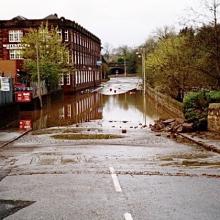
Parts of Edinburgh struggled to cope with a sudden downpour on 24 June.
Over half the month’s anticipated rain fell in three hours on the west of the city, and some 140 floods were reported during what Transport & Environment Convener Cllr Lesley Macinnes later described as an ‘exceptional period of extreme weather’.
Traffic disruption ensued. There was some localised but serious damage to property.
Broughton escaped the worst of it, but all this brought to mind the flood of 26 April 2000 (pictured above and HERE) and, more recently, a local planning application which first caught Spurtle’s attention last summer and has been nagging away at us every time it’s rained since.
Below, Spurtle takes another look at the context of that application (first reported HERE) and its approval later. In particular, this article examines an official body’s response with implications beyond Broughton.
The starting point is a conclusion by senior government scientists that the much vaunted Water of Leith Flood Prevention Scheme (FPS), completed in January last year at an overall cost of over £43M, is not as effective as residents, officials, and elected members originally expected.
It’s a complicated issue that takes time (please be patient) and isn’t conclusive. We’ll try to unpick it as simply as possible.
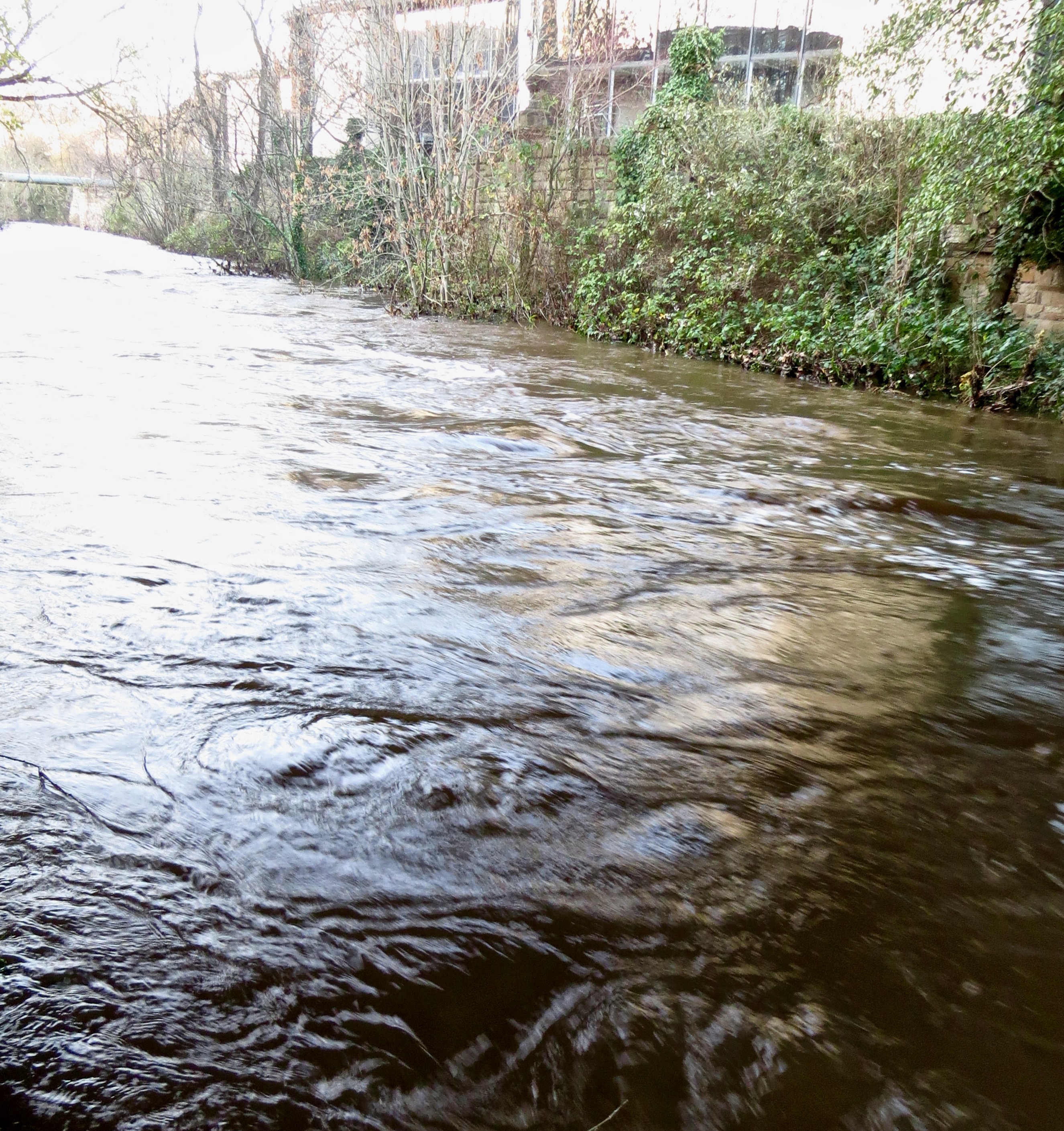
Not all it’s cracked up to be?
The scientific reservations appear in a report of July 2018 from the Scottish Environmental Protection Agency (SEPA) to City Development at Edinburgh Council (‘Comments from SEPA’, 27.11.18, Ref. PCS/159455).
This was a written response to the Council’s consultation concerning an application to replace offices with 11 flats at 5 Warriston Road (Ref. 18/02451/FUL).
SEPA objected to the proposal on the grounds that it might ‘place buildings and persons at flood risk contrary to Scottish Planning Policy’.
SEPA then went on to give detailed reasons.
SEPA considers residents (‘new risk receptors’) to be highly vulnerable to the effects and impacts of flooding.
For highly vulnerable developments such as the one at 5 Warriston Road, SEPA’s guidelines call for the minimum appropriate standard of flood protection to be 0.5% annual probability (a one-in-200-year event) plus, since August 2017, an appropriate allowance for climate change comprising a ‘20% uplift‘ (see panel).
But the Water of Leith FPS was planned before the 2017 revision came in. Hence, its appropriate allowance is only 12%, and the 5 Warriston Road development initially reflected this.
There follows an eye-boggling section from SEPA’s report:
Whilst we understand that the site is afforded some level of protection from the Water of Leith Flood Prevention Scheme there are uncertainties associated with the standard of protection the scheme affords.
We do not consider, based on best science, that the allowance for climate change is adequate to meet the projected increase in flood risk in the coming years. As such the Water of Leith FPS does not provide the minimum standard of protection that we require for highly vulnerable land uses.
The location of the proposed development is at risk during a 0.5% (200 year) annual probability plus climate change event on the Water of Leith and, although behind a FPS, will continue to be at risk.
Just take a moment to let that sink in.
In short, SEPA advised that no FPS completely eliminates the risk of flooding, but where an FPS like this one on the Water of Leith ‘does not provide an acceptable standard of protection for the site’ then a new development should not be built as it doesn’t meet Scottish Planning Policy requirements.
The best way to avoid flood risk is not to build in an area liable to flood.

No ducking deep concerns
Now, if any reader wants to dive into the specifics of the Warriston Road application, they’re welcome to follow the link above and examine the separate report by officials to the Development Management Sub-Committee.
That report outlines how the developer responded to SEPA recommendations by increasing the freeboard to 600mm, which – the Council’s Flood Team assert – would meet even a 30% climate uplift.
It points out that the (eventually consented) design comprised ‘flood-resistant and resilient design and materials’, with safe ‘flood free access and egress’.
Here, though, we return to SEPA’s original technical flood-risk report (Ref. PCS/159455). SEPA elaborated on its misgivings about the development in an Appendix that has wider relevance to sites elsewhere along the river.
In particular, it highlighted:
- Shortcomings in how, when planning the FPS, the Council’s consultant had estimated flow rates in the Water of Leith. Assessments were made by looking at the record for only one spot, at Murrayfield; and two floods (in 1920 and 1948) comparable to the one in 2000 had not been considered at all. SEPA suggested that an event like the 2000 flood was likely to occur more often than the Council had been informed: once every 70 years rather than once every 100 years.
- Further technical ‘uncertainties’ in how the flow estimates had been reached included the fact that estimations were based on storms lasting 10.5 hours. However, the meteorological record shows flood-generating storms on the Water of Leith have lasted longer, closer to 24–48 hours.
- When the FPS was being designed and at the subsequent local inquiry, planners said that upstream reservoirs would be used to manage flood reduction. However, the Council has subsequently confirmed that no such management takes place: ‘As such, there would appear to be greater uncertainty regarding the storage that the reservoirs might provide during extended wet periods or back-to-back storms.’
- Earlier consultants have assumed that 21 sqkm around the Water of Leith would drain into Edinburgh’s urban sewerage system. But if that assumption is wrong, flood levels at the Stockbridge Colonies and downstream could be 200mm higher than previously expected.
- Add this uncertainty about urban sewerage to other doubts about reservoir management and possible ‘bridge blockages’, and there is the potential for an increase in the water levels at the Stockbridge Colonies to be ‘approximately 780mm higher’.
None of these wider issues was addressed in depth by the Planning officials’ Report to the Development Management Sub-Committee about 5 Warriston Road, which promised vaguely to provide ‘adequate drainage’ (3.3.g).
Because SEPA had objected to the Warriston Road proposal, Edinburgh Council was obliged to refer the case to Scottish Ministers.
Scottish Ministers, however, considered that, since SEPA-recommended mitigation measures had been met, Edinburgh Council should proceed as it saw fit. Final planning consent was duly granted in April 2019.

Edinburgh Council confident
Last August, before the Development Management Sub-Committee, a Council Flood Prevention Officer asserted that hydrology is a ‘dark art’ (Item 7.2, 3:40–45).
He said it is dependent on evolving understandings. He characterised SEPA’s approach to it as theoretical and turbid, the Council's as pragmatic and clear.
In the last two weeks, though, officials have laid more stress on mutual understanding and cooperation. They tell Spurtle that, on completion of Phase 2 of the FPS, it was always their intention to update the mathematical hydraulic model (water/sewer/storm system) in the light of the newly constructed flood defences.
As part of this update, they continue, their consultant Arup will in future ‘improve data for assessing planning applications and providing advice’ and ‘better inform SEPA of the level of protection provided by the scheme’.
The review will also give them an opportunity to adopt current updated standards. The existing Council standard for flood risk is ‘30% climate change allowance’, higher than the SEPA-recommended 20%. However, similar to the flood model being developed, this new allowance will change in line with latest guidance to 40%. Developers are now being informed of the change.
This firm ‘Keep calm and carry on’ message is reiterated by Council Leader Cllr Adam McVey in a response to Spurtle enquiries.
‘SEPA have raised valid concerns relating to the impact of climate change, which we are taking very seriously,’ he writes.
‘We are currently in the process of updating our model for how the Water of Leith Flood Prevention Scheme operates to ensure we have the most up to date information to identify flood risk and deal with any issues.
‘This was planned in the original scheme and will be carried out to current standards recommended by SEPA and will help confirm the level of defence for the defences already built and improve data for assessing planning applications near the river, which will involve SEPA as a statutory consultee.’

A different perspective
So is everything all right, then? Not necessarily.
Spurtle approached local resident Alexander Hill for an alternative expert perspective on the flood and climate challenges facing Edinburgh.
Hill is the former Head of the London Weather Centre, and was the Met Office Chief Advisor to the Government of Scotland from 2008 until his retirement in 2014.
His first observation concerns just how complicated a problem the combined flood-risk management strategy (published by SEPA in 2015), the implementation plan (subsequently published by City of Edinburgh Council), and the interim progress report (published in May 2019) represents for all concerned.
SEPA isn’t in charge. Rather, in an advisory role, it oversees ‘a Spaghetti Junction of legislation and conflicting goals,’ says Hill. Responsibilities are explained HERE and HERE.
A little clarity is offered by the Flood Risk Management Act (Scotland) 2009, Hill offers encouragingly.
‘With the exception of floods solely from sewerage systems, which are the responsibility of Scottish Water, the Act says, “flood” means the temporary covering by water from any source of land not normally covered by water.
‘In other words, a flood is a flood is a flood. It doesn’t matter where the water comes from, and, in reality, when flooding occurs it is normally a combination of two or more of these sources that is responsible.’

Mares that go splash in the night
Hill goes on to paint a plausible ‘nightmare scenario’.
Heavy rain falls for 24 hours near the source of the Water of Leith.
It collects, and begins flowing towards Edinburgh. Next, rain – similar to the quantities we saw on 24 June – falls on the city itself. Unfortunately, it’s a high spring tide [the next is on 19 July], and the combined water from source and city has nowhere to go.
‘Individually, none of these events is especially dramatic. None necessarily meets the one-in-200-year-event criterion. But in combination, the resultant flood could be devastating.’
It’s worth noting that on 24 June, in an event which involved only one of these components, much of the localised flooding was caused by what the Council later described as ‘blockage or capacity issues’ in Scottish Water surcharging sewers, overflowing gullies managed by the Council, or ‘the road drainage network [which] is not designed to cope with unanticipated rainfall of such intensity’.
Hill points to substantial difficulties in how the authorities try to plan for such events. In what he describes as SEPA’s ‘scathing’ technical report on 5 Warriston Road, for example, the one-in-200-year-event + 20% uplift criterion is referenced. But nowhere is there a clear definition of it.
‘Is it, for example, an excessive amount of rain over 6 hours or 12 or 24, or even longer? Together or individually, these events along the Water of Leith catchment will have a different impact.’
Then there’s the issue of infrastructural design standards. Understanding of drainage systems, for example, has been based on historical data, and mostly doesn’t consider climate change. ‘There are numerous examples of present-day infrastructure being overwhelmed by the new climate reality, and this will only get worse.’

What next?
Disaster risk-management is becoming more and more significant globally, as the climate crisis unfolds.
For it to be effective, says Cliff Hague – Emeritus Professor of Planning and Spatial Development at Heriot-Watt University, and Chair of the Cockburn Association – we need firstly to work harder at joining up know-how across professional boundaries between scientists and insurers, and secondly to get their combined knowledge to permeate the planning system.
Deciding where new development should be located, he stresses, should be based on best-available evidence. But while SEPA can provide non-binding advice, ‘Decisions on controversial applications are likely to be taken by councillors, for whom it’s not easy to balance long-term flood risk against promises of short-term benefits such as housing with developer contributions attached.
‘Developers themselves are unlikely to want to pass up the fortunes bestowed by planning permissions unless a site is actually under water during construction. And in Edinburgh, they tend not to see the key role of public open space in absorbing water, seeing only the economic potential of developing an area.’
Despite such qualifications, Hague can envisage a more positive alternative in Scotland. ‘Drawing on local knowledge’, he says, ‘imaginative flood mitigation and adaptation could be a catalyst for creating new neighbourhoods or regenerating older ones, as is already happening in Copenhagen.’

Unconvinced
The author of this article is a Broughton resident.
For all Professor Hague’s guarded optimism about potential improvements to flood-related planning, I’m more concerned by his identification of the difficult balance councillors must strike between much needed housing development and caution.
Here, I see ample room for fudge, error, and disastrous short-termism. Like other sceptics in the area, my own (hydrologically inexpert) local knowledge leads me to fear the worst.
As well as development at 5 Warriston Road, locals observe the old public toilets on Brandon Terrace being converted to restaurant use. The former Earthy site on Canonmills Bridge will soon be new homes and retail space. Canonmills Garden in Puddocky is rising fast. So too will new homes on Newhaven Road.
Since May, we’ve had Gormleys back in the water beside the Powderhall floodplain and Anderson Place, this time rigidly attached where before they were collapsible in order to prevent the build-up of debris and – you guessed it – flooding.
But against this generally permissive Planning background, SEPA’s fundamental position (reconfirmed to Spurtle yesterday) is unchanged: ‘Whilst the Water of Leith FPS offers a significant level of protection to existing housing, we would advise that new housing should not be built behind a scheme with this standard of protection.’
SEPA has been in communication with all local authorities in Scotland regarding the revised climate-change assessment, and has held workshops to discuss the findings and their potential use.
And yet, here and elsewhere across the country, we seem to keep building in flood-risk areas regardless, relying on best guesses, mitigating measures, and a significant degree of wishful thinking to keep residents’ new homes above water.
Reflecting on 24 June’s events and praising the effectiveness of the Water of Leith FPS, Cllr Macinnes last month commented: ‘Though this was something of a freak storm, it’s reasonable for the public to expect an efficient response to the problems caused by it.
‘We will, of course, build on lessons from this week’s flooding and continue to work with partners to improve and adapt our reaction to such events as a city, benefiting residents, commuters and visitors.’
Local residents hear all that. We mostly accept our Council’s and elected members’ good intentions.
But the nightmare that continues to nag away in our heads is this: ‘Freak’ storms are rapidly becoming the unpredictable norm.
Frankly, none of us in Edinburgh is adequately prepared to cope with the consequences.—Alan McIntosh
[For flood warnings, visit the SEPA Floodline. For City of Edinburgh Council's advice on 'What to do in a Flood' and more, visit their website.]
SEE ALSO 2020 UPDATE AT: https://www.broughtonspurtle.org.uk/news/flood-management-needs-vision-and-leadership
Got a view? Wade in at spurtle@hotmail.co.uk and @theSpurtle and Facebook
--------------
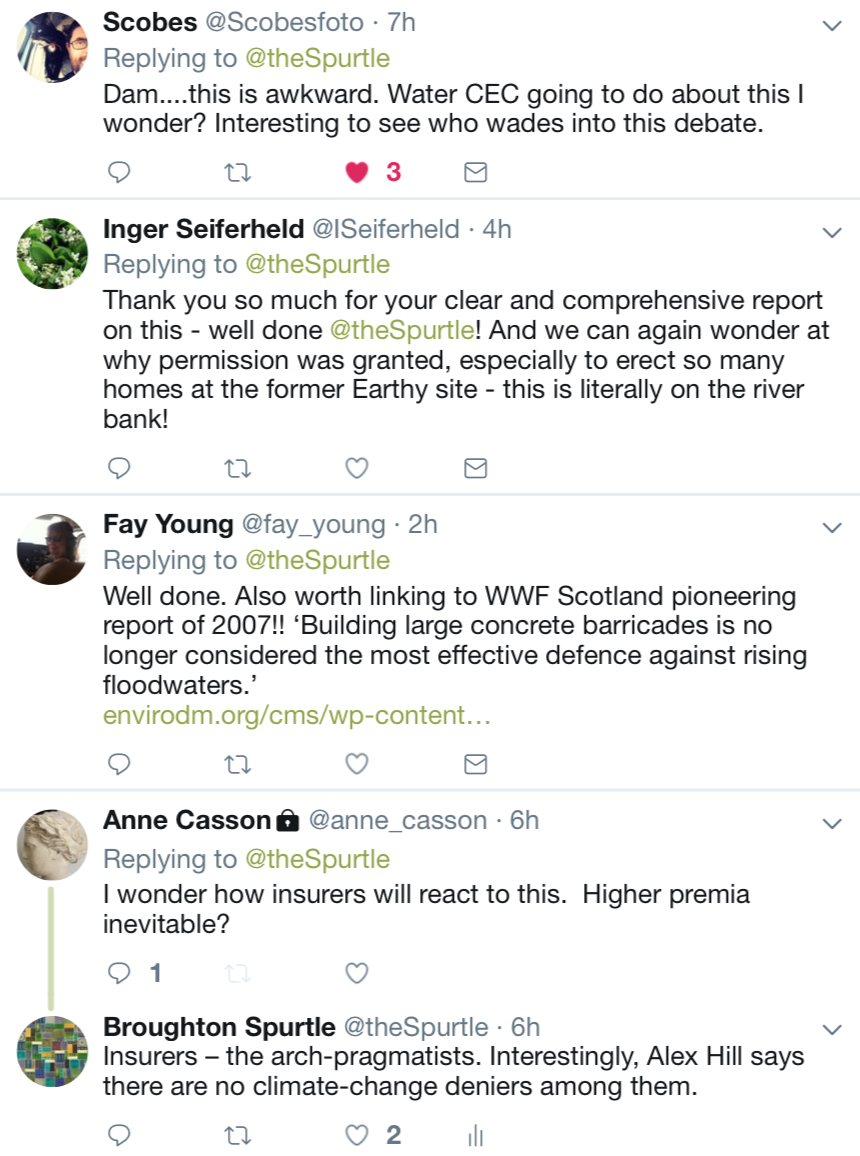
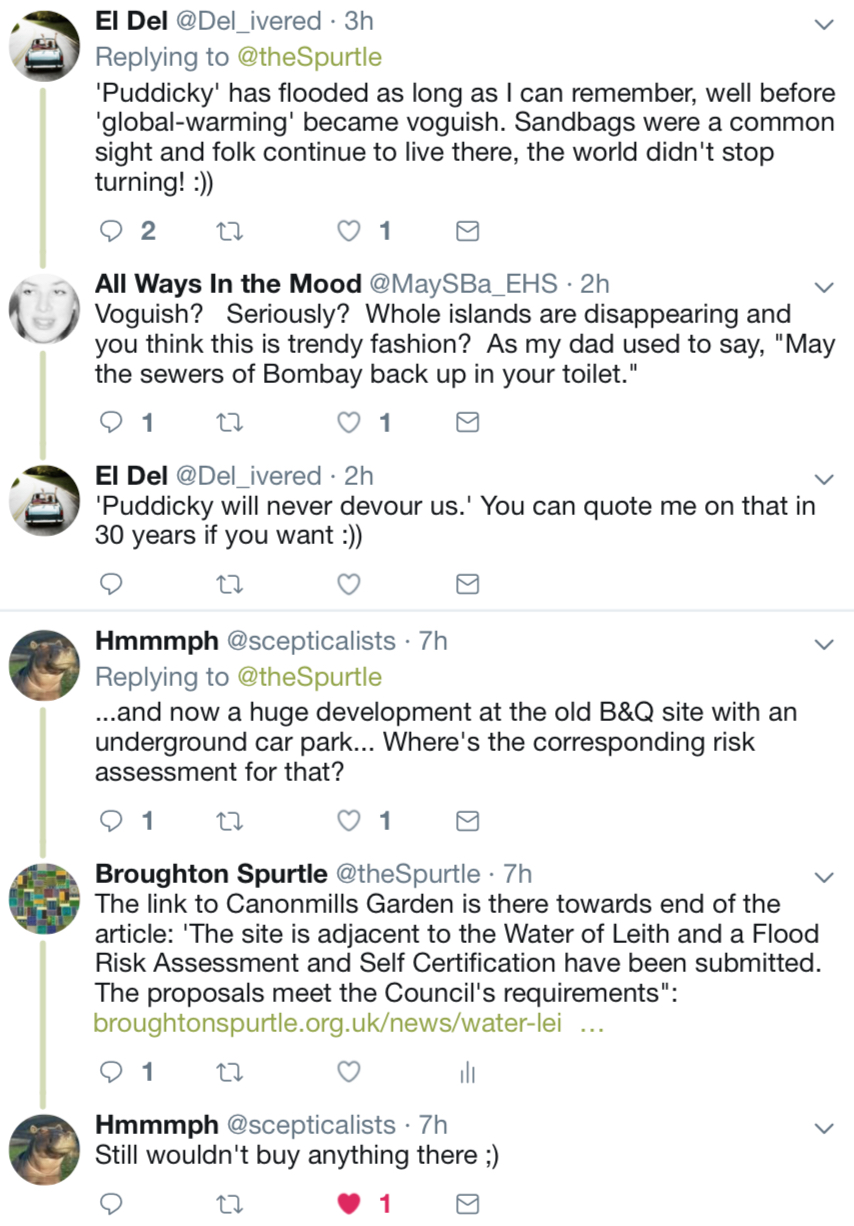



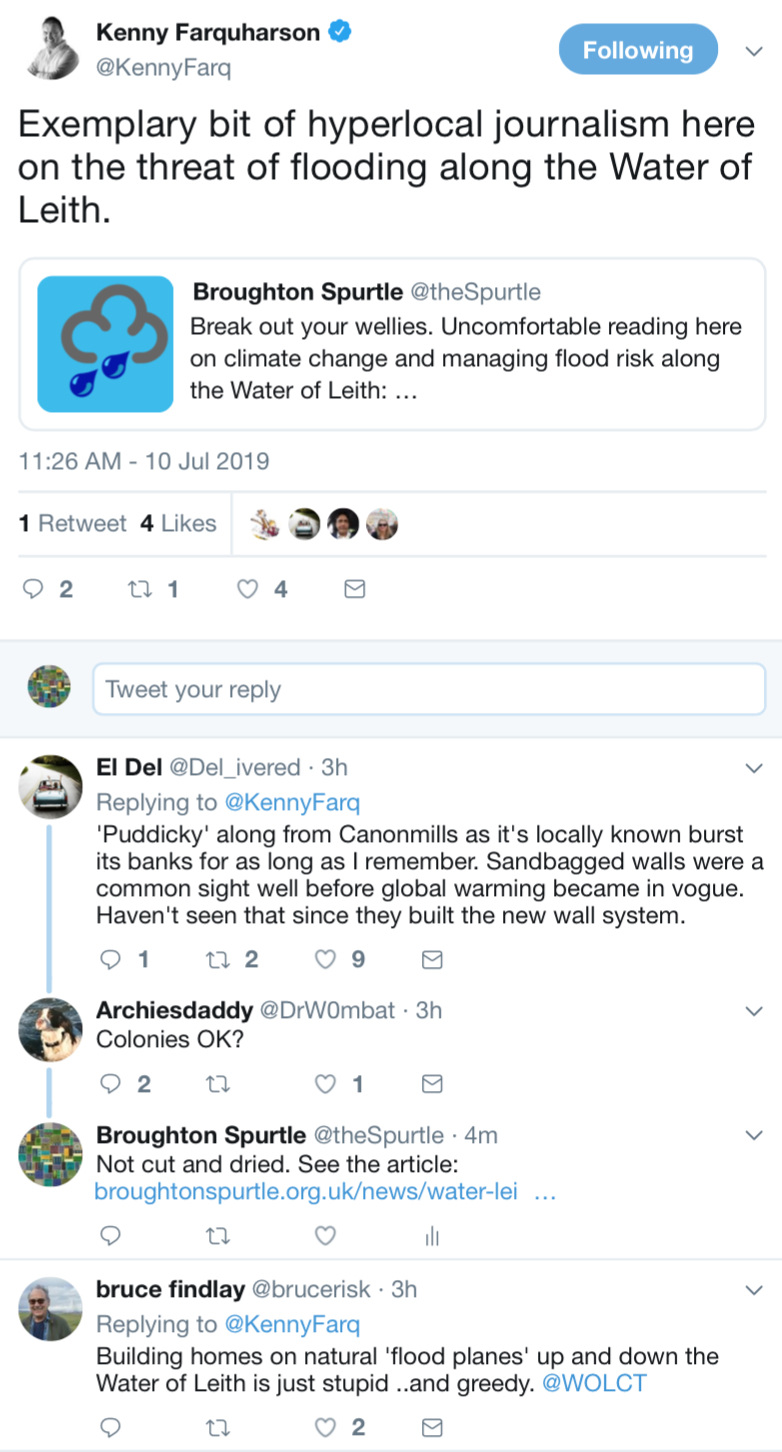
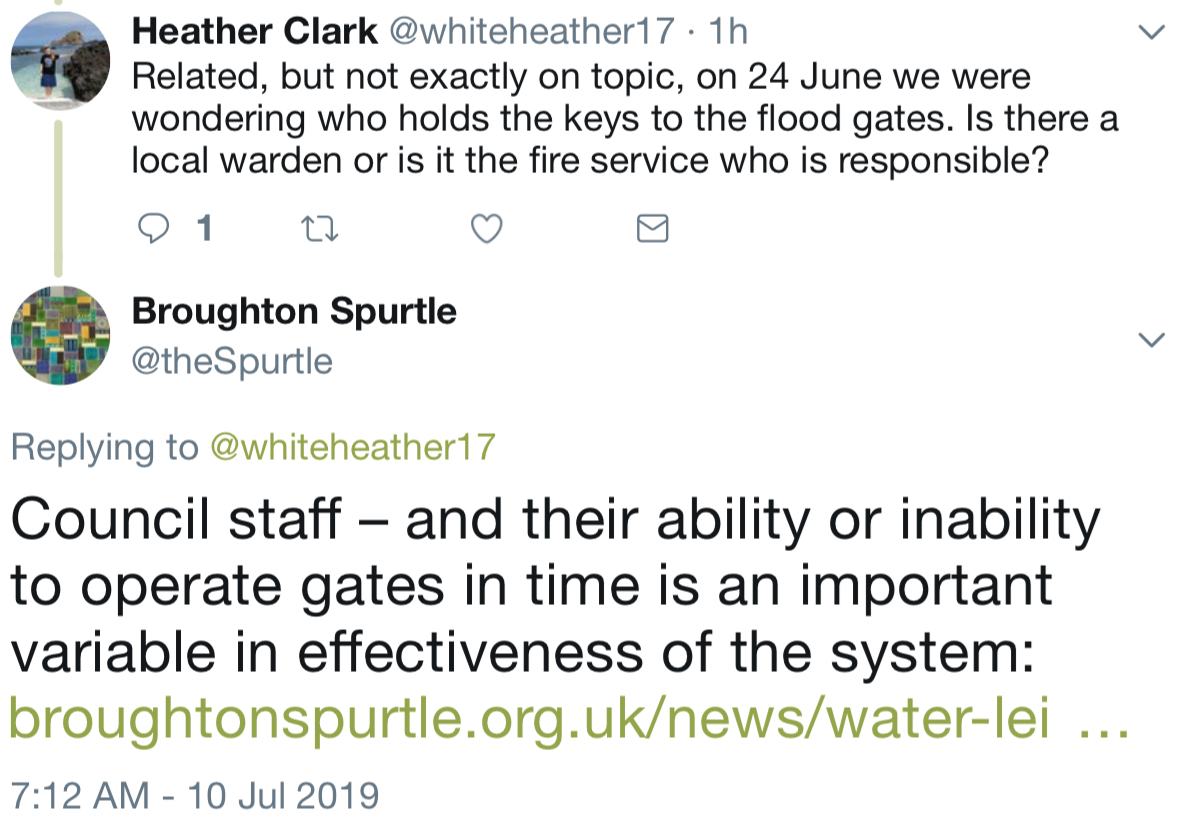

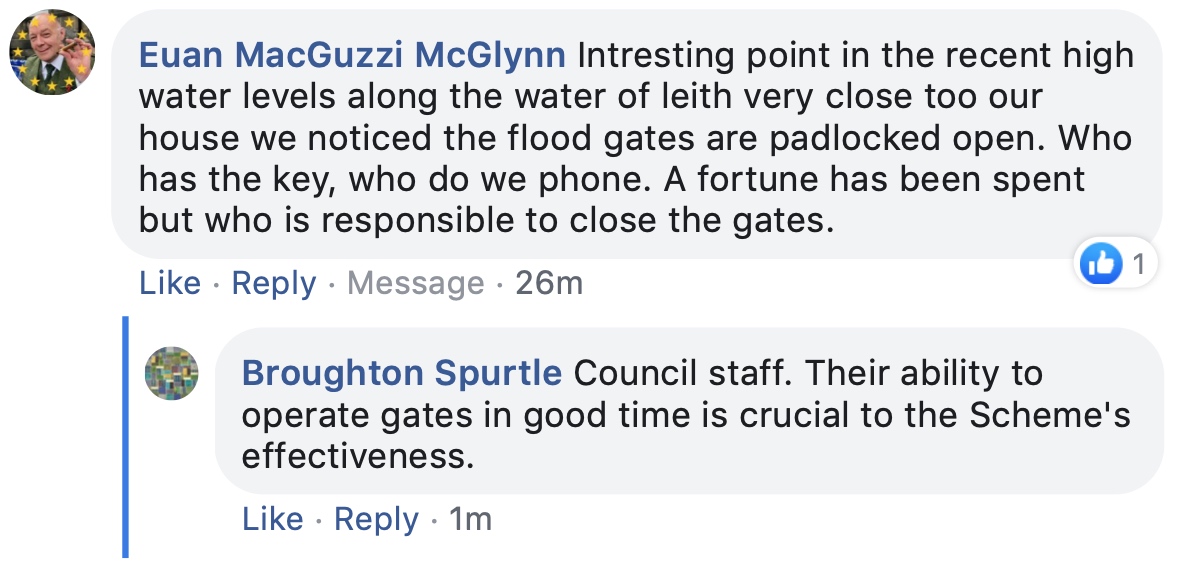
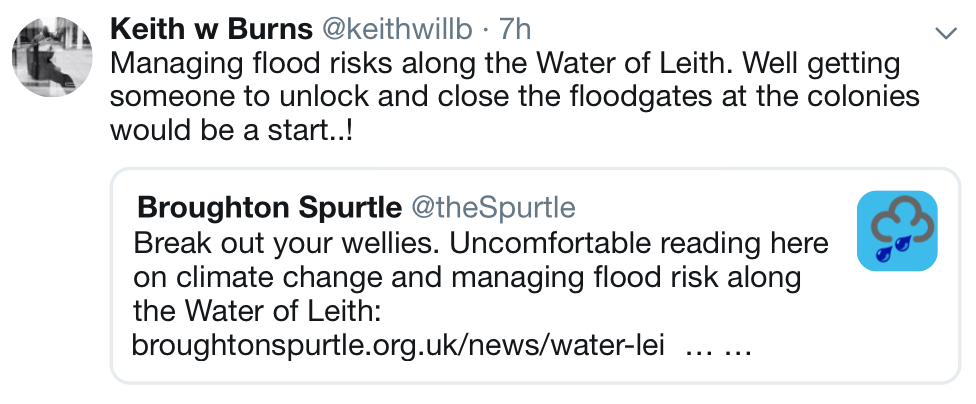

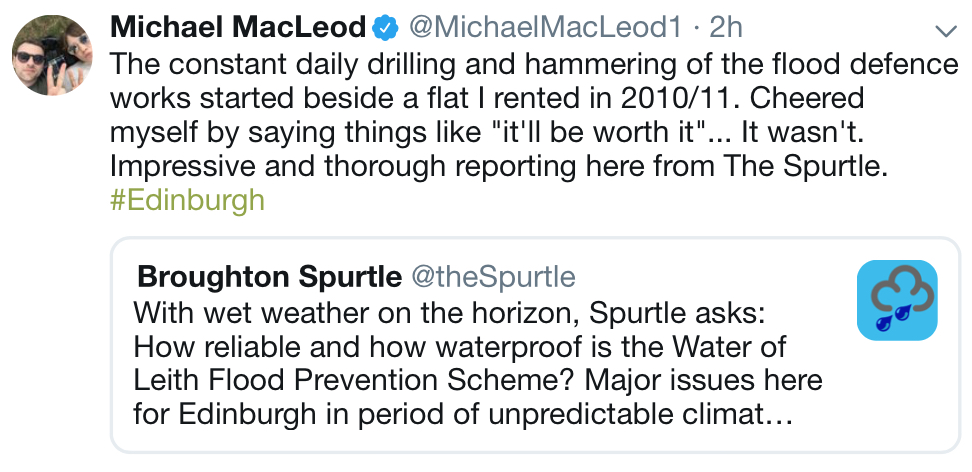


Dear Spurtle,
Rainfall in Scotland can hardly be described as an unexpected occurrence, and an increase in future severe weather events is probably inevitable.
But the situation in Edinburgh is not helped by a Kafkaesque interaction between various actors: the Local Authority, which prioritises housing development on floodplains which are then no longer available to take the overflow during heavy rain; Scottish Water, responsible for an antiquated and poorly charted sewerage system, but not for clearing gullies or the supervision of adequate implementation of a Sustainable Drainage System (SuDS); the National Galleries of Scotland, responsible for clearing debris gathered behind the Gormleys; Forth Ports, in charge of the Leith harbour basin and the lock to discharge the Water of Leith into the sea; and Scottish Ministers, who often overrule their own expert agency, SEPA, in planning cases.
Add to this the routinely granted planning approval of paved driveways being laid over front gardens, every time increasing the total hard surface area in Edinburgh and the demand on the drainage system, and I am inclined to agree with Alexander Hill's assessment (though not with his chosen metaphor): flood planning and management is 'a Spaghetti Junction of legislation and conflicting goals'.
Harald Tobermann, Vice Chair, Leith Central Community Council [11 July 2019]
Dear Spurtle,
Re: 'How Reliable, How Waterproof'
Between 2 November and 10 December 2004, a Public Inquiry heard evidence from Edinburgh Council, its engineers, and concerned members of the public regarding the proposed Water of Leith Flood Prevention Scheme (FPS).
The Inquiry was supported by a chartered civil engineer with specialist experience of flooding, and the Inquiry Report (in April 2005) attempted to give balanced and impartial recommendations. This Report was refreshingly forthright in its criticism of aspects of the FPS design.
It recommended that ‘Scottish Ministers should not confirm the Water of Leith Flood Prevention Scheme until the City of Edinburgh Council has … carried out further investigations and analysis to remedy any deficiencies in the hydrological analysis [etc.] and until any necessary adjustments have been made to the scheme arising from this additional work’.[1]
However, in March 2007, Scottish Ministers overruled the Report's recommendations, concluding that ‘there are no defects in the … hydrological analysis [etc.] which would cause them to require their re-examination’.[2]
Last year, the Scottish Environmental Protection Agency (SEPA) re-examined the Inquiry concerns, and it now advises that new accommodation should not rely on the Water of Leith FPS.[3] Whilst hydrology is not an exact science, the position regarding the Water of Leith FPS should be clearer than it is. There should be more agreement, less dispute.
To be fair, the Scottish Ministers gave reasons for overturning the Inquiry recommendations, and the Inquiry engineer, I imagine, would have been persuaded in many respects. He may still have requested further analysis, though, especially with respect to hydrological questions and climate change. But whilst the Council and their Engineer were involved in discussions, persuading the Scottish Executive, it is not obvious that the Inquiry team was similarly involved.
Recent Council communication has highlighted climate-change increases, which is ironic because the Inquiry was clear that ‘insufficient allowance has been made for climate change’,[4] and suggested that the 12% allowance be doubled or more.[5] (The Inquiry also indicated that the choice of 12% rested with the Council, for ‘[the designer was] instructed to design on the basis of a 12% increase … to allow … for climate change’.[6])
However, the Scottish Government ruled that ‘the allowance made for climate change is reasonable … and was based on the best available science at the time’.[7] The italics are mine; the wording already seeming to acknowledge that the climate-change allowance was out of date. The Inquiry recommendation now seems reasonable; it is in line with the figures currently being discussed.
Hopefully, progress will be made in resolving the other (non-climate-change) concerns raised by SEPA (and the Public Inquiry). One puzzling issue may be quickly addressed: at the Inquiry, the engineers all agreed on the significance of managing the upstream reservoirs for flood reduction.[8] In March 2007, ownership of the reservoirs passed to the Council, which was expected to facilitate management. To learn now from SEPA that the reservoirs are not being managed for flood reduction begs the questions: Were the engineers mistaken, or does the Council simply have insufficient resource to manage the reservoirs?
If reservoir management can significantly reduce the flood risk, then it's worth demanding as the cost should be relatively low.
Bill Geary [29 July 2019]
BSc (Civil Engineering), MSc (Water Engineering)
[1] Water of Leith FPS Public Inquiry, Final Report, April 2005, clause 6.14.1
[2] Scottish Executive decision letter dated 15 March 2007, clause 17.
[3] See investigative report by the Broughton Spurtle (online), 10 July 2019.
[4] Water of Leith FPS Public Inquiry, Final Report, April 2005, clause 6.8.
[5] Water of Leith FPS Public Inquiry, Final Report, cl.5.26; Technical Report cl.1.51 & 52.
[6] Water of Leith FPS Public Inquiry, Technical Report, April 2005, clause 1.47.
[7] Scottish Executive decision letter dated 15 March 2007, clause 16.1.
[8] Water of Leith FPS Public Inquiry, Final Report, April 2005, cl.1.48, 1.145, 2.23, 5.79.